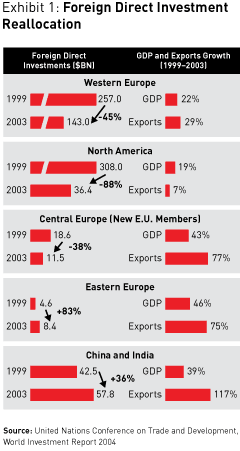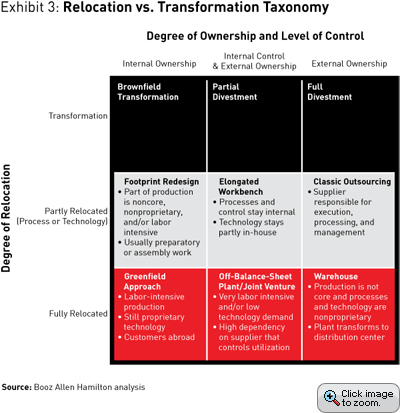Relocate? Transform? Which Option Is Right?
How to make smart decisions that will maximize manufacturing efficiencies.
(originally published by Booz & Company)A few companies in the West have stubbornly and successfully refused to bow to competition from low-cost countries. One example is an industrial materials producer in Europe, which was facing an onslaught of competition from cheap Korean and Chinese imports. Instead of simply assuming it was overmatched, the company refocused its product portfolio so that its customer base would be only the leaders in their sectors — in other words, manufacturers that were interested in product quality and willing to pay a premium for it.
To make its prices more competitive, the industrial materials producer installed new continuous production technology in its European plants and outsourced a small number of technical and engineering operations to the East. In addition, the company took an aggressive stance against predatory pricing by suing its Korean and Chinese competitors for dumping in European markets.
It was a risky strategy, but it worked. Since beginning its campaign against its Eastern rivals, the industrial materials producer has been more than holding its own in Europe. And although it is likely that in time the company will have to shift some operations to the East to continue to meet customer price demands, when it does so, it will be in the advantageous and uncommon position of being able to operate thriving plants in both the West and low-cost nations.
The industrial materials producer is a distinct exception, however. Today, it is hard to imagine a strategic manufacturing agenda that does not have offshoring and outsourcing to low-cost nations as its primary components. The opportunity to leverage the favorable labor costs that low-cost countries offer is simply too enticing to pass up, especially when the low labor costs are so near Western markets (for example, Eastern Europe’s proximity to the more developed part of the continent).
 As a result, since 2001 there have been significant increases in capital investment inflows into Asia and Eastern Europe. (See Exhibit 1.) These capital investments typically seek the lowest-cost manufacturing environments and ultimately reject regions that rise above this standard. Take Eastern and Central Europe, for instance. Although both areas are experiencing GDP and export growth on par with India and China — the paradigmatic low-cost nations — the standard of living in Central European countries (particularly the new European Union member states) has increased along with prosperity, making these countries less desirable for foreign investments than their lagging neighbors in Eastern Europe.
As a result, since 2001 there have been significant increases in capital investment inflows into Asia and Eastern Europe. (See Exhibit 1.) These capital investments typically seek the lowest-cost manufacturing environments and ultimately reject regions that rise above this standard. Take Eastern and Central Europe, for instance. Although both areas are experiencing GDP and export growth on par with India and China — the paradigmatic low-cost nations — the standard of living in Central European countries (particularly the new European Union member states) has increased along with prosperity, making these countries less desirable for foreign investments than their lagging neighbors in Eastern Europe.
But in the headlong rush to take advantage of lower costs, many companies underestimate the hidden potential of improving productivity in Western brownfield locations as well as the risks and complexity associated with offshoring. And they overestimate the promise of manufacturing in low-cost countries. Moreover, businesses often believe incorrectly that they have no strategic choices except those two opposing possibilities. But between the extremes of brownfield transformation and relocation lies a world of options, a territory that only a few creative companies have explored. For most others, these intermediate strategies remain uncharted terrain.
Offshoring May Not Be a Panacea
Booz Allen Hamilton believes that when economic trends seem to support relocation, it is often only because companies are treating short-term expense reduction as the sole consideration. However, by taking this view, organizations fail to assess the effects of relocation on their long-term strategic objectives, and the potentially high costs involved. For example, many companies outsource portions of their production to low-cost nations because they believe it will help them save money and get a leg up on rivals. But in doing this, they may overlook the risks of creating future market adversaries, which before long could seriously weaken their competitive position around the world.
China offers an apt illustration. To develop manufacturing operations in China, Western companies often must set up joint ventures with local Chinese partners. However, it has become increasingly obvious that these partners may attempt to do little more than learn and adapt knowledge in order to run their own factories that compete against their former joint-venture colleagues.
Recently, another possible cost of relocation has sprung up, although it has gone mostly unnoticed. Customers are increasingly seeking a share of the profit when companies shift operations to low-cost countries. For instance, in Germany, automobile buyers demanded vehicle price reductions after they learned that the components they were purchasing were made in Slovakia rather than locally.
The problem is that existing decision models for both transformation and relocation do not thoroughly incorporate the risks of execution. To accurately gauge the cost of greenfield solutions, manufacturers would have to quantify a large number of less-than-advantageous items — including brownfield exit costs, greenfield ramp-up costs, and potential disruptions to the supply chain. They would also need to calculate whether the supply chain is resilient enough to quickly return to normal, determine labor wage instability and churn rates in low-cost countries, consider the potential defection of workers to competitors, factor in loss of goodwill, and allow for bonuses paid to key employees who would manage the move, among many other things. These expenses are rarely fully captured in decision-making equations; hence, a bias against brownfield transformation is created.
The management attention required to open a new factory in a distant site is also often underestimated. When managers are distracted by multimillion-dollar construction efforts that will require massive resources and greatly increased staff development, other parts of the company naturally get less notice. In turn, significant opportunities may be passed over that would otherwise be immediately exploited.
At the average company today, it is significantly less risky for a manager to advocate moving factory operations to the East than it is to suggest enacting a sweeping reform of the Western manufacturing base. This is simply because the former is such a popular option — “everybody’s doing it.” In some cases, managers fear that some budget categories relating to the decision of relocation or transformation may be underestimated or ignored, and to compensate for this they artificially increase projected expenditures to create a “buffer” against mistakes. This has the unintended effect of making it virtually impossible to make an accurate judgment about factory location, because such a judgment needs to be based on data that is transparent, precise, and consistent.
Given that relocation efforts are usually motivated by the desire to cut labor costs, it’s troubling to see how many labor variables are neglected when the option to offshore is chosen. Recently, we requested manufacturing bids from a number of low-cost country suppliers, asking not only for their hourly rates but also how long it would take to produce and ship the parts. Somewhat surprisingly, we found that because of inferior work practices and lack of experience as well as the refusal of local partners and authorities to fully pass on expected labor cost savings, 75 percent of the so-called low-cost manufacturers were actually more expensive per unit produced than their Western counterparts. (See Exhibit 2.)
Another overlooked labor cost is the expense and difficulty of hiring indirect personnel and middle managers in low-cost nations. These types of employees are often in short supply, even in areas with high unemployment rates. As a result, either their salaries are much higher than most companies anticipate — they are basically on par with those in the West — or these professionals turn out to be volatile workers who hop from one company to the next. We estimate that about 25 percent of plant managers in China make at least 20 percent more gross salary than their European counterparts. And the significant threat that competitors could lure away indirect personnel, even after a company devotes considerable time and effort to recruit them, applies to more than the most senior and technically apt employees. A Europe-based confectionary company that had set up a plant in Russia recently learned the cost of this scramble for employees when it had to increase the pay of its forklift drivers after a number of them left to join a U.S. food company 60 miles down the road. Some, in fact, took their forklifts with them.
Because decision models are typically math-based, they are unable to reflect political give-and-take between management and unions in brownfield locations that could significantly decrease the costs of manufacturing. There are many recent instances of union concessions relating to, for instance, increased working hours without concomitant salary hikes that change the relocation/transformation equation. And some companies and unions are cooperating in novel ways that would have been almost impossible as recently as five years ago. One example involves GM in Europe, which created a competition among its plants to determine the site that could offer the greatest productivity improvements and labor cost efficiency. The results of this exercise are that GM plans to move manufacturing operations for the next generation of Saab 9-3 models to the automaker’s Opel plant in Ruesselsheim, Germany, from its traditional facility in Trollhattan, Sweden.
Supply chain and infrastructure challenges in a relocation strategy can also be intractable. It’s not always easy to set up a factory in a low-cost site to which the supply base can efficiently deliver without incurring many additional, unexpected costs. These added charges as well as the risks of having to sometimes sign up untested suppliers to stock a new factory could increase the price tag of relocation significantly. Additionally, the potential expense of improving infrastructure should be taken into account: Companies must analyze the condition of roads and communications lines to determine whether they are sufficiently robust to sustain increased traffic in the future. Further, the red tape (or political connections) required to convince municipalities and utilities to provide a consistent and sufficient supply of water, energy, sewage services, and many other essential aspects of a plant cannot be controlled and often are not fully known until the factory is built. Often, during negotiations with local authorities, promises are made that authorities have no real intention of keeping.
The importance of a broad-based and diligent analysis of a relocation site was illustrated recently by the slip-up of an aerospace components company that decided to shift some parts production to a company in Siberia. Aerospace company executives visited the prospective plant site in the summertime, never once contemplating the effect that average annual temperatures of –12°C might have on its precision parts. The company, now locked into a long-term contract, is still struggling to get adequate parts from this factory and is considering buying itself out of the agreement.
The increasing desire to minimize supply chain costs and eliminate complexity in operations has also begun to highlight some of the problems with relocation strategies. Because of this, at least a few companies are finding it difficult to justify using plants in low-cost countries. A maker of synthetic materials for the automotive industry recently learned that some customers that had defected to Asian manufacturers were considering returning to Western suppliers because the working capital and complexity charges associated with sourcing 300 product varieties from 30,000 miles away were becoming untenable.
What’s the Alternative?
With offshoring often less advantageous than it’s cracked up to be, some companies are choosing transformation of existing plants in higher-cost nations and uncovering substantial benefits. To assess the alternatives to relocation, we’ve considered them within the four categories (inherent, structural, systemic, and realized) of our “ISSR” manufacturing framework. This framework offers an analysis of the cost differences and cost drivers between plants.
Inherent level: At the inherent level, which involves the technologies and processes used in manufacturing, some companies are implementing customized production lines that are designed to remove factory inefficiencies. In some cases, these systems allow the company to slash the price of manufacturing so steeply that the presumed advantages of low-cost nations are eliminated. A leading European consumer goods company, for example, developed a suite of manufacturing technologies that outperformed off-the-shelf machines by as much as 50 percent: This was achieved through line speeds more than 30 percent faster than those of off-the-shelf systems used by competitors, through end-of-line packaging automation that was previously believed to be impossible, through modular technologies that allowed for minimal downtime during maintenance overhauls, and through factory layouts that allowed technicians to tend to two lines simultaneously. With this setup, the company is able to profitably maintain manufacturing facilities close to customer markets and suppliers practically anywhere in the world.
Structural level: At the structural level, which involves the location, size, and activity of plants, organizations are segmenting operations on the basis of locale. Typical is the plan orchestrated by a German machine builder. The company successfully separated its manufacturing processes into an upstream parts and components metalworking operation located in Eastern Europe and a downstream assembly and testing center near corporate headquarters. By doing this, the company essentially placed its commodity operations in a low-cost region and kept its high-quality, high-skills-needed tasks in the home region, where enough trained labor and supervisory oversight was available to ensure that these processes were being managed correctly. In the process, the company realized that past outsourcing moves had wrongly favored “around the church spire” solutions — that is, outsourcing only within their local region. These approaches are now outdated owing to a very rapidly developing supplier base in Eastern Europe.
Systemic level: The systemic level involves the implementation of in-plant manufacturing practices that produce optimally performing operations. Perhaps paradoxically, such lean manufacturing principles are more easily implemented in the low-cost East. Indeed, our belief, based on empirical evidence, is that making a fresh start in a greenfield factory is often the best way to instill “leanness,” as excellence can be engineered and embedded from the beginning. But programs such as Total Productive Maintenance (TPM) are often harder to implement in low-cost countries because the lack of skills and the relatively low level of employee education demand a more heavily supervised style of management. Also, the relatively high churn rate of employees makes it harder to train workers for the more active participation required in lean manufacturing.
In addition, certain manufacturing processes are better suited for the West, near customers, marketing, and R&D staff in corporate headquarters. The debut of a new product is one example. Most automobile, pharmaceutical, and aerospace companies, which have high innovation rates, have suffered dismal product launches when low-cost countries have been involved in manufacturing — problems include late shipments, budget overruns, misplaced items, or simply low quality. For these companies, moving manufacturing facilities to low-cost nations, far from other functions critical to a product launch, is clearly a high-risk option.
One strategy is to design, engineer, and produce essential new products near corporate headquarters and shift manufacturing to lower-cost facilities after the product gains traction in the marketplace. At this systemic level, we have also observed that some pioneering companies are entirely rethinking which functions to locate in plants and which to centralize — challenging conventional wisdom about what are typically considered “plant functions” such as maintenance, quality assurance, planning, and scheduling. The German utility E.on, for example, made a significant shift recently by regionalizing its maintenance staff — in other words, having maintenance teams that circulated to many plants in an area rather than being attached to just one. This drastically cut the number of people required on-site at individual factories.
Realized level: At the realized level, which involves work-force management and labor issues, low-cost nations invariably have the edge, thanks to limited salaries, benefits, and perks. However, in most developed countries, unions are now willing for the first time to consider changes in work structure that would have been unfathomable a short time ago. Among them: the 40-hour workweek, fewer vacation days, layoff plans that favor those who find jobs elsewhere quickly, and flexible time accounts in which the number of employees needed is matched with the amount of goods that must be produced at a given time. But even with these changes in attitude, it will take decades for labor practices in the West to resemble those in the East.
Our conclusion is that examined carefully, factories in Western nations often hold the possibility of transformation significant enough to make them competitive with plants in low-cost countries. This transformation can usually be accomplished by aggressively pulling inherent and structural levers. But these factories do require a significant investment in human capital, asset funding, and time if they are to run at the desired output and cost. Indeed, if CEOs in Europe had considered all of the separate financial, labor, infrastructure, and technical challenges involved in relocation or transformation, many plant relocations from France, Germany, and the Netherlands to Eastern Europe would not have happened, and many others would have happened in a different way.
The Answer Is Somewhere in Between
In our experience, companies that manage the low-cost-nation quandary best do not rely solely on a strategy of relocation or transformation, but instead choose the appropriate approach as well as a variety of blended possibilities depending on the circumstances. Among the range of options that companies have are jointly setting up a so-called extended workbench by outsourcing manufacturing segments to external partners in low-cost countries and handing over ownership to a partner abroad. (See Exhibit 3.)
To begin to decide which model fits best, a company must ask these questions:
Are the manufacturing technologies or installed processes
-
Proprietary?
-
Core competencies?
-
More accessible in traditional markets?
-
Capital-intensive rather than labor-intensive?
-
Dependent on shop-floor know-how?
The more these questions are answered “no,” the greater the chance that relocation or some other external plant approach is the best option. But besides these intrinsic questions, companies also should pose some structural queries, such as:
-
Is it imperative for reasons of quality or logistics to keep suppliers and distribution close to the customer base?
-
To what degree is manufacturing productivity or effectiveness influenced by the potentially different plant scale and labor costs?
-
What is the customer demographic footprint, and how stable does product demand flow have to be?
We have found that when these questions are taken into account, many companies choose a stepwise approach to relocation and realize significant benefits from doing so. In one recent case, a German aerospace parts manufacturer was hoping to cut costs by implementing an extended workbench in Eastern Europe. Although manufacturing capabilities were, in general, available at the sites under consideration, local processes in Eastern Europe did not meet the company’s quality and service standards, and they lacked the equipment necessary to satisfy the required plant volume. So the aerospace company decided to “test the waters” by equipping an Eastern European supplier with older milling and bending machines, which were located in one of the German company’s brownfield locations and were slated to be replaced soon, and then shifting 25 percent of its parts volume to this supplier.
By introducing a new process allowing make-to-stock production and by transferring to Eastern Europe only simple, high-volume parts with few quality problems, the aerospace company gave the supplier a real chance to move up the learning curve quickly and meet the necessary lead times. At the same time, the supplier was still highly dependent on the aerospace company, since final quality checks continued to be controlled in the West and the equipment that the supplier was using was only borrowed from the aerospace company.
A similar differentiated approach was adopted by a German manufacturer of agricultural equipment, which badly needed to catch up with competitors that had already established low-cost factories in Eastern Europe and Asia. Closing plants in Western Europe was not a particularly good option for this company, because it would be prohibitively expensive. So instead of a wholesale move East, the equipment manufacturer decided to take a gradual approach and outsource only parts of its production. The strategy was called “rolling up from the bottom.” The company began by finding or developing metal-forming and parts facilities in the Czech Republic. The paint shop and final assembly, however, remained in the West to maintain quality control on final production.
Also, in its brownfield plants, the company replaced fixed working hours with flexible time accounts. This allowed the equipment maker to better handle seasonal demand fluctuations and trim labor costs in its Western sites at the same time. With this go-slow strategy, the company ultimately transferred to low-cost countries about one-third of its payroll and more than one-fifth of its costs.
By examining the issue of relocation versus transformation in an open, broad-minded, and diligent way — that is, without knee-jerk responses — companies can plan a manufacturing strategy that is both profitable and defensible. If, after a careful analysis, it turns out that manufacturing in the West is not sustainable, it will be far easier to intelligently argue for relocation with stakeholders, increasing the chances that shifting operations to, for instance, Russia, Turkey, or China will be successful. After all, customer, employee, or union backlash can spoil relocation at its earliest stages. It is perfectly evident to employees, unions, suppliers, and customers when factory decisions were not based on a detailed comparison of transformation-versus-relocation options.
This means that “relocation or transformation?” should not be viewed as a dilemma; instead, it is an opportunity for companies to revisit their manufacturing strategy and create an outcome that generates the most lucrative returns and the most positive stakeholder response.![]()
Hans-Jörg Kutschera (kutschera_hans-joerg@bah.com) is an associate with Booz Allen Hamilton in Munich. Mr. Kutschera focuses on manufacturing strategy, cost reduction, make-or-buy decisions, and factory footprint optimization.
Peter Obdeijn (obdeijn_peter@bah.com) is a senior associate with Booz Allen Hamilton based in Amsterdam. His focus is on cost restructuring of manufacturing companies, with an emphasis on revitalizing plant networks by taking advantage of opportunities in low-cost countries.
Michael Ilgner (michael.ilgner@sporthilfe.de) was formerly a principal with Booz Allen Hamilton in the Munich office, where he focused on manufacturing and supply chain strategy. Currently, Mr. Ilgner is managing director and board member of the German Sport Foundation (Stiftung Deutsche Sporthilfe).
Peter von Hochberg (von_hochberg_peter@bah.com) is a vice president with Booz Allen Hamilton based in Düsseldorf. He has extensive experience in consulting with clients on manufacturing and lean production, focusing on automotive OEMs and suppliers, and industrial goods manufacturers.






